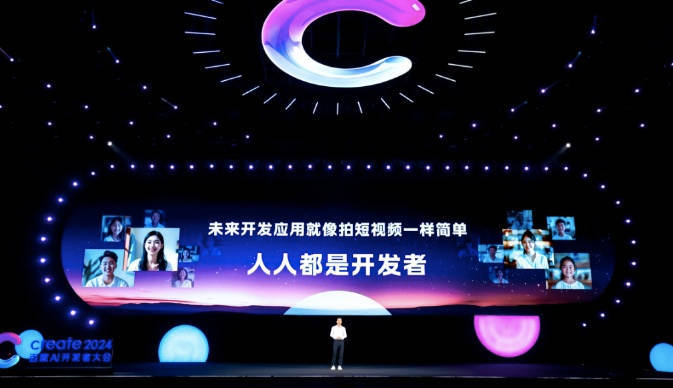
百度提供的图片
On April 16th, at the Create 2024 Baidu AI Developer Conference, Baidu’s founder, chairman, and CEO, Robin Li, officially announced the release of the Tool Edition of Wenxin Large Model 4.0.
Li stated that compared to a year ago, the algorithm training efficiency of the Wenxin Large Model has increased by 5.1 times, with a weekly training effectiveness of 98.8%, and the inference performance has increased by 105 times, while the cost of inference has decreased to 1% of the original. “That means, under the same cost, customers who used to make 10,000 calls a day can now make 1 million calls a day.”
Li also revealed that since its launch on March 16th last year, the number of Wenxin Yiyan users has exceeded 200 million, with daily API calls surpassing 200 million, serving 85,000 customers or enterprises, and over 190,000 AI native applications developed using the Qianfan platform.
Li emphasized that large language models themselves do not directly create value; AI applications developed based on large models can meet real market demands. He shared three strategies for developing AI native applications based on large models:
First, future large-scale AI native applications will mostly be MoE, which means the hybrid use of large and small models, not relying on a single model to solve all problems.
Second, small models are more cost-effective. Small models have lower inference costs and faster response times. In some specific scenarios, finely tuned small models can achieve effects comparable to large models. This is also the reason why Baidu simultaneously released ERNIE Speed, ERNIE Lite, and ERNIE Tiny, three lightweight models today.
Third, intelligent agents significantly reduce development barriers and enable the generation of AI native applications with low code or even zero code.
Li stated that intelligent agents are currently a hot topic, and as their capabilities improve, they will continuously generate a large number of AI native applications. The mechanism of intelligent agents includes understanding, planning, reflection, and evolution, enabling machines to think and act like humans, autonomously perform complex tasks, continuously learn in the environment, and achieve self-iteration and self-evolution.
“In some complex systems, we can also allow different intelligent agents to interact and cooperate with each other to complete tasks with higher quality. We have developed these capabilities and fully open them to developers,” Li said.
Li introduced that because the basic model Wenxin 4.0 can tailor smaller-sized models according to needs, considering factors such as effectiveness, response speed, and inference cost, and supports fine-tuning and post-pretrain. Models obtained by dimensionality reduction and tailoring perform significantly better than models obtained directly from open source models of the same size or at significantly lower costs. “So open source models will fall behind.”
Li’s viewpoint contradicts that of many industry insiders. In a recent speech at Harvard University, Zhou Hongyi, founder of 360 Group, said, “Without open source, there would be no Linux, no internet, and even our own development relies on open source technology.” He predicted that in the next one to two years, the power of open source technology might surpass that of closed source technology.
Zhou Hongyi said, “The current capabilities of open source models cannot reach GPT-4. However, by focusing on one direction, strengthening capabilities through proprietary data and professional training, it is possible to surpass GPT-4 in professional capabilities.”
In March of this year, Zhu Xiaohu, managing partner of GSR Ventures, expressed a similar view: “At present, open source lags behind closed source by one generation, but in the long run, open source will definitely catch up.” In addition to this, domestic leading large model startups such as Baichuan Intelligence and Zhipu AI have also chosen the open source route.
However, there is no definitive conclusion in the debate over which is better, closed source or open source. “Objectively speaking, in the domestic market in 2023, Baidu’s system and method in the field of large models are ahead of other domestic internet companies, which shows its accumulation in artificial intelligence,” said technology analyst Zhao Song to Time Weekly.
As the first internet company in China to launch a chatbot and challenge ChatGPT in internal testing, Baidu has a certain first-mover advantage in the field of artificial intelligence. In fact, as early as March 2019, Baidu benchmarked Google’s BERT model and launched the Wenxin Large Model ERNIE 1.0, claiming that its Chinese effect surpassed BERT, and reached 100 billion parameters in December 2021, crossing the threshold of “intelligent emergence”.
“Baidu, along with Alibaba, Tencent, and Huawei, is in the first echelon of the large model industry and is recognized as a ‘versatile player’ by the industry. Baidu has built a relatively comprehensive system in the fields of large models, large model tool platforms, the reconstruction of large models for its own applications, and the large model ecosystem including developer incubation,” Zhao Song said. “At present, the gradual improvement of basic large model capabilities and the landing application scenarios are the difficulties faced by domestic large model enterprises.”
When Li mentioned the topic related to “landing” in his speech, he said, “The best AI native applications have not yet emerged, whether in China or the United States.” He believes that just as the mobile era gave birth to “mobile-native” applications like WeChat and TikTok, the AI native era will definitely see the emergence of new super applications developed based on large models.
However, the emergence of these super applications will not happen suddenly in a short period of time. This requires continuous iteration of basic large model technology capabilities and the increasing participation of more developers.
The content on this website (including but not limited to text, pictures, and audio and video) is copyrighted by Time Weekly. Without written agreement, reprinting, linking, reposting, or other use is prohibited. Violators will be held legally responsible. If other media, websites, or individuals reprint or use it, please contact Mr. Ding of this website: [email protected].